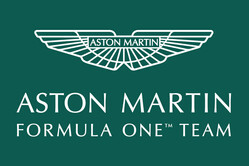


04/01/2021
NEWS STORY
 As Aston Martin reveals its team logo, team boss, Otmar Szafnauer says he senses within the team extra energy and a determination to "push performance further than ever before".
As Aston Martin reveals its team logo, team boss, Otmar Szafnauer says he senses within the team extra energy and a determination to "push performance further than ever before".
Just one minute into the new year, the Aston Martin F1 Team revealed its logo, and while we will have to wait until February to see the car, said logo suggests race fans are about to witness the return of British Racing Green to the grid.
While Aston Martin has enjoyed success in Sportscar racing in recent years, highlighted by multiple class victories at the 24 Hours of Le Mans, its F1 activity has been minimal and almost six decades ago.
In 1955, Aston Martin's owner, Sir David Brown hatched a plan to create cars that would take on the best competition in both the World Sportscar Championship and the relatively new Formula 1 World Championship.
While the history books focus on the achievements of the Le Mans-winning DBR1, and the DB3S that preceded it, the initial venture into single seaters, DP155, could be seen as a valuable learning exercise for the brand, and was the precursor to the later 1950s Grand Prix cars. Alongside this project, Sir David initiated work on a new engine, and a new road car design that would become the DB4.
So it was, then, that the Aston Martin DBR4 came into being. Tested as early as 1957, it was not until 1959 that the car made its competition debut at the BRDC International Trophy event, run to Formula 1 rules, at Silverstone in May of that year.
Two cars competed and car no. 1, driven by 24 Hours of Le Mans winner Roy Salvadori, came in a creditable second behind Jack Brabham in a Cooper-Climax T51. Powered by a 2,493cc, dry sump, six-cylinder RB 250 engine, from the same basic design as the DBR1 sports car engine, the DBR4/250 was a 256bhp spaceframe single seater which weighed in at 575kg.
Despite being driven by some of the star names of the era, Salvadori and Carroll Shelby among them, the front-engined DBR4 was out of step with the new mid-engined competition and failed to mirror in Formula 1 what it's DBR1 cousin famously achieved in the sports car arena. After a disappointing debut for its successor, the DBR5, Aston Martin withdrew from top-flight single seater motorsport in 1960.
All that is about to change.
"We've had almost a year of preparation to reach this point," says CEO & Team Principal, Otmar Szafnauer, "and we're really looking forward to seeing the reaction when we finally unveil our new identity as the Aston Martin Formula One Team.
"Representing such an iconic brand is a huge privilege for every member of the team," he continued. "We've earned a well-deserved reputation for punching above our weight, so we're confident we can do the Aston Martin name proud right from the get-go.
"It's the start of a new journey and I can sense an extra energy in the team, with a determination to push performance further than ever before.
"Combined with some of the most creative minds in the business, a true racers' mentality and the can-do spirit that has served us so well through the years, we have every reason to be excited about the future."
"Formula 1 is a hugely powerful platform that will play a key part in the overall Aston Martin strategy as we seek to take the company forward," added Lawrence Stroll. "It is a truly global sport with a huge audience that we believe can help reignite the brand and further increase its desirability all over the world.
"This is a brand that has already had huge success in top-level international motorsport such as the 24 Hours of Le Mans - and now we have an opportunity to write a new page in the history books.
"That's a hugely exciting prospect for anyone who is a lover of the Aston Martin brand, for fans of Formula 1 and the sport itself."